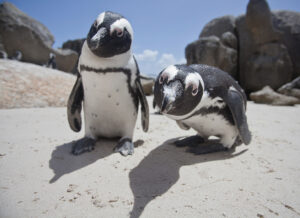A passion for the natural world drives many of our adventures. And when we’re not actually outside, we love delving into the discoveries about the places where we live and travel. Here are some of the best natural history links we’ve found this week.
Leaky mitochondria help sea otters stay warm: Mitochondria help to generate energy in muscle cells. It turns out that leaks in a sea otter’s mitochondria cause its body temperature to rise. It can thus maintain a resting metabolism three times faster than predicted for an animal of its size. Researchers also found that the leaking was not constant. It could be activated when more warmth was needed.
Dark wings supercharge seabird flight: Scientists have compared the wing coloration of 324 species of bird to their flight performance. They found that birds with darker wings tended to be better flyers. The darker feathers absorbed more heat and made flying more efficient. Birds with dark wings experienced 20% less drag when flying. It is hoped that the research will feed into drone and aviation technology. “This is actually going to be the future of science, where the combination of two different areas helps us come up with new studies,” said biomimicry researcher Mostafa Hassanalian.
North Baffin hunters ask Baffinland not to break ice: Hunters from Pond Inlet have asked the Baffinland Iron Mines Corporation not to do any icebreaking near the northern tip of Baffin Island. There is growing evidence that the practice is harmful to narwhals. In recent years, the number of narwhal seen in the area dropped from 9,931 to 5,019. “It’s time for Baffinland to take serious action to stop this disturbance, including cancelling its planned icebreaking,“ said Eric Ootoovak. Icebreaking affects the stress level and health of the narwhals, “making the narwhals skinnier and less nourishing.”

A ship leaves Baffinland Iron Mines Corp.’s port. Photo: nunatsiaq.com
Prehistoric people hoarded, too
Iron age people were emotionally attached to objects: People living 2,000 years ago also had difficulty parting with sentimental objects. In Scotland, items such as bone spoons and game pieces have been found in an Iron Age roundhouse. Archaeologist Lindsey Büster notes that these low-value items that wouldn’t be “grave goods”. She concluded that people kept them for emotional reasons. “These little caches of objects aren’t necessarily accompanying the dead and they are not high material value or of exotic quality,” she says. “But they are clearly not just rubbish either. They have been very deliberately deposited.”
South Africa’s language spoken in 45 clicks: Katrina Esau, 88, was crowned Queen of the Western Nǁnǂe (ǂKhomani) San in 2015. Her community is on the outskirts of Upington in South Africa’s Northern Cape. The language of the ǂKhomani people is N|uu, but since 1931 they have scattered around South Africa. Now just two people fully speak the language: Esau and her brother. While English has 44 distinct sounds, N|uu has 114. It also incorporates 45 meaningful clicks. Esau is now making every effort to teach her beloved language to younger generations.
Freeze-dried mouse sperm produces healthy pups after six years in space: In 2013, researchers from Japan sent freeze-dried sperm from twelve mice to the International Space Station. The samples went back to Earth in batches after one, three, and six years. Researchers then rehydrated the samples to see if they could still fertilize egg cells. Some had DNA damage but all of them still produced healthy pups. It is the first time that any form of sperm has been in space for this long. Lead researcher Teruhiko Wakayama hopes that one day, humans could populate other planets using sperm and egg cells from Earth.

Polar bear on an ice floe. Photo: Jerry Kobalenko
Sea ice disappearing much faster than predicted
‘Last refuge’ for polar bears is vulnerable to climate: The Wandel Sea area in the Arctic off northeastern Greenland is known as the “last ice area”. It normally has thick ice year-round, but new analysis shows record melting there last summer. Most climate models did not predict such a low level of sea ice in 2020. Researchers thought that it would take decades to reach this point. Marine scientists are particularly worried as this is an important habitat for polar bears, seals, and walruses.






